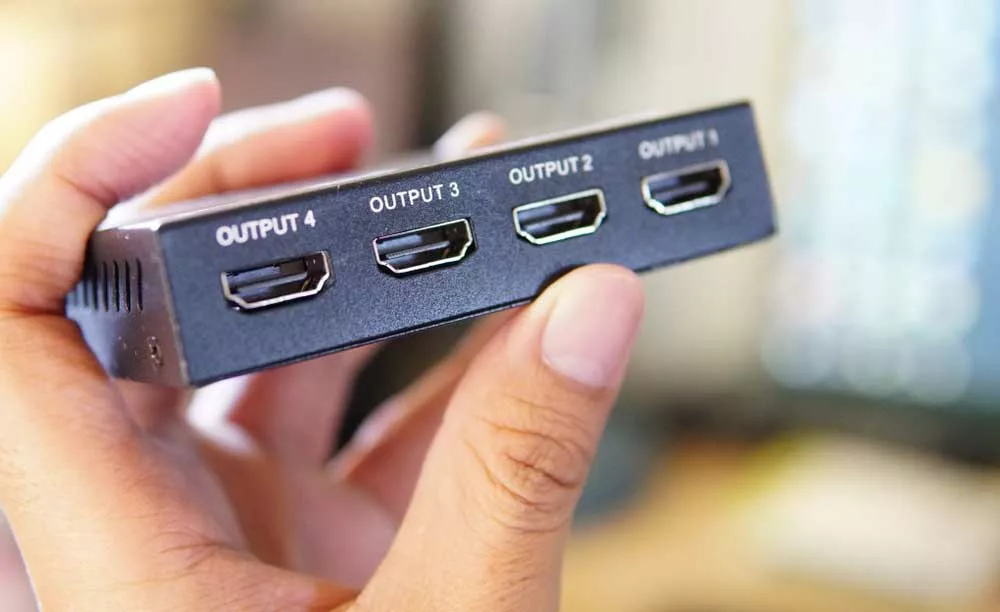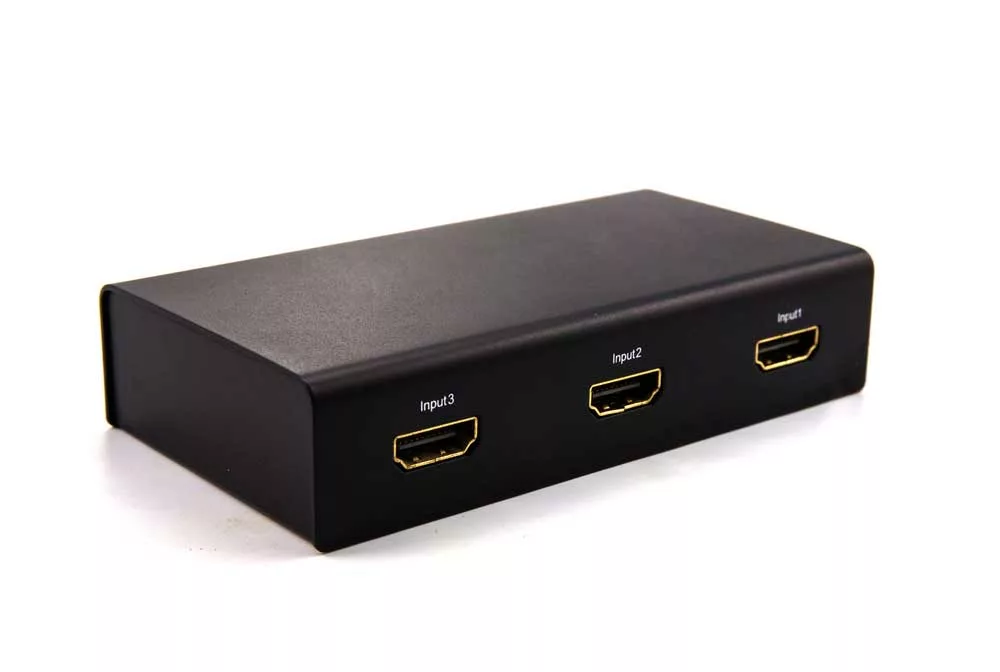About HDMI splitters, You own a bar or a restaurant and have one source device that shows live sports games.
You want to distribute it to different TVs placed at other places in your bar or restaurant.
However, older source devices do not have enough HDMI ports to connect all display devices.
So what can you do? Is buying more source devices a solution?
Maybe YES, but it is not a versatile and cost-effective solution.
The best would be to use an HDMI splitter to send signals from one device to multiple output devices.
What is this HDMI splitter, and how does it work?
Let’s find out in this blog post.
Table of Contents
- What is an HDMI splitter?
- Differ an HDMI splitter from an HDMI switch?
- What are the benefits of using an HDMI splitter?
- What specifications do you need to consider while buying an HDMI splitter?
- Conclusion:

An HDMI splitter with four outputs
What is an HDMI splitter?
An HDMI splitter allows you to distribute HDMI signals from a single source device to multiple display devices.
An HDMI splitter has one input and multiple output ports, often indicated as 1*2, 1*4, etc.
You can connect any HDMI source device like a DVD player, cable box, Blu-Ray player, or PC to the splitter’s input port and your multiple display devices to its different output ports.
You can split the audio and videos into multiple streams and then connect to different TVs or monitors separately and simultaneously.
Differ an HDMI splitter from an HDMI switch?
HDMI splitters and switches are helpful and expensive devices to make your TV system functional, but people are confused with them a lot. Let’s see the difference between these two.
HDMI splitters for one source and many displays:
As the name implies, you have one source device to send HDMI signals, which multiple display devices receive simultaneously or separately.
This use case benefits bars and restaurants where they want to display ads or menus on multiple displays.
Further, you can also use an HDMI splitter to display ads on different TVs.
Here, you can use a one-to-many HDMI splitter, which takes signals from one source TV and sends them to multiple displays.
HDMI switchs for many sources and one display:
The setup has multiple input/source devices. Consider setting up your living area entertainment system.
You have numerous source devices like Blu-Ray players, firestick, game consoles, etc.
Most modern TVs come with multiple HDMI ports, but changing between the ports can be cumbersome.
Here, you will need an HDMI switch which takes signals from multiple source devices and casts one of them to your display.’
Difference between HDMI splitters and HDMI switches
| Key difference | HDMI splitter | HDMI switches |
| Functionality difference | An HDMI splitter takes signals from one source and casts them on multiple screens. | An HDMI switch takes signals from multiple sources and casts them on one monitor via cable output. |
| Labeling difference | An HDMI splitter labeling is (input ports*output ports). For example, a 1*3 labeled HDMI splitter has one input port and three output ports | An HDMI switch labeled as 4:1 indicates four input and one output port. |
| Configuration difference | Two types of HDMI splitters in the market: Splitters installed with a network cable, which are more suitable for HDMI signal transmission over long distances. Splitters with an HDMI cable. You can find HDMI splitters in numerous configuration options. | Different sizes of HDMI switches are available; however, the most common and valuable is 4*1 having 4 input sources and one output source. Ensure that the switch you use is compatible with your device. You must get one that does not cause signal lag. This becomes more important when your source device is a game console or PC because, here, latency affects the gaming performance. |

An HDMI switch with 3 inputs
What are the benefits of using an HDMI splitter?
Like other things, HDMI splitters have limitations but can meet most of your needs.
HDMI splitters help you save a lot of costs.
Suppose you have one set-top box. The splitter takes data from this source and can display content (your favorite movie, maybe) to all the displays placed in different rooms.
You need not buy more cable boxes and pay separate subscription fees.
Also, one source device can cost you around $100 and buying a 1*2 or 1*4 splitter will cost you only around $50, which means a lot of savings.
Besides, an HDMI splitter helps you get rid of cable clutter.
You only need HDMI cables to connect the source and display device, and you are done.
In offices or homes, an HDMI splitter is an advantageous product where multiple cords create a lot of confusion and clutter.
What specifications do you need to consider while buying an HDMI splitter?
While choosing an HDMI splitter, you must know the exact specifications based on your situation.
HDCP management
Sometimes, splitters cannot split HDMI signals due to high-bandwidth Digital Content Protection or HDCP.
It is a feature in media players, cable boxes, and TVs, ensuring you are not playing pirated content.
You can get splitters with HDCP management, which authenticates HDCP encryption among different devices.
It ensures that correct content from the source gets displayed on the display.
Displays:
Like source displays, you must count the exact number of displays if your setup has multiple displays with one source.
Check if all your displays are the same or different. A regular HDMI splitter works best with all identical displays.
However, try to get a high-quality splitter with variable aspect ratios and resolutions if you have different displays.
Image quality and latency:
HDMI splitters split signals from the source and send them to different displays.
In this setup, all the multiple displays perceive the same picture, whether full HD or ultra HD, with the same audio quality as sent by the source.
However, HDMI splitter goes through different issues like resolutions drop, artifacts, or color changes.
Also, low-quality splitters transmit identical signals to all display devices with different latencies.
So, ensure that you invest in high-quality to get a good image quality.
Also, all monitors must have the same frame without anyone lagging over the others.
Conclusion:
Get an HDMI splitter and connect the input port to the source device and output ports to other TVs in your shop.
Also, don’t forget to invest in high-quality HDMI cables for best results.
Contact Cloom for any custom HDMI and other cables customized to our client’s requirements.
